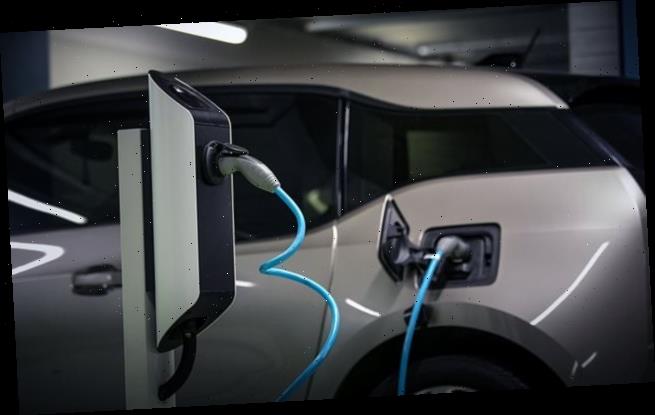Driving up emissions: Polluting plug-in hybrids are the car industry’s ‘wolf in sheep’s clothing’ spewing out two and a half times more CO2 in real life than reported from lab tests
- Hybrid vehicles are run off of a combination of battery power and combustion
- Greenpeace and Transport & Environment ran their own tests on hybrid cars
- This said they emit 188.3 grams of CO2 per mile, not 70.8 grams as advertised
- The UK will be banning new sales of petrol and diesel vehicles in the near future
- Environmental groups are calling for hybrid cars to be added to this prohibition
Spewing forth an average of two-and-a-half times the carbon dioxide on the road as they appear to in lab tests, plug-in hybrid vehicles are a ‘wolf in sheep’s clothing’.
This is the warning of groups Greenpeace and Transport & Environment, who argue for hybrids to be added to the upcoming ban on new petrol and diesel cars.
Hybrid cars run off of a battery which can be charged either from the electricity grid, or via their conventionally-fuelled onboard engine.
While they are often marketed as low-carbon alternatives to traditional vehicles, the groups’ analysis suggests that a typical hybrid emits 188.3 grams of CO2 per mile.
This is compared with the figure of 70.8 cited from laboratory examinations — a discrepancy that the groups blame on the vehicles’ limited range.
In addition, they said, hybrid owners do not recharge their vehicles’ batteries often enough — increasing their emission levels when driven in reality.
UK Transport Secretary Grant Shapps has indicated that a ban on the sales of new petrol, diesel and hybrid vehicles could be brought forward from 2040.
The accelerated time frame would help meet carbon reduction targets.
Spewing forth an average of two-and-a-half times the carbon dioxide on the road as they appear to in lab tests, hybrid vehicles are a ‘wolf in sheep’s clothing’. This is the warning of groups Greenpeace and Transport & Environment, who argue for hybrids to be added to the upcoming ban on new petrol and diesel cars. Pictured, a hybrid charges (stock image)
‘Plug-in hybrids are the car industry’s wolf in sheep’s clothing,’ said Greenpeace UK’s head of politics, Rebecca Newsom.
‘They may seem a much more environmentally friendly choice, but false claims of lower emissions are a ploy by car manufacturers to go on producing SUVs and petrol and diesel engines,’ she explained.
‘It’s great that the Government is considering bringing the ban on new petrol and diesel vehicles forward to 2030 — doing so is one of the most important things the Government can do now to help tackle the climate emergency.’
‘But ministers mustn’t be duped by plug-in hybrids when making this critical decision,’ Ms Newsom continued.
It’s imperative that they are included in the 2030 ban, and that support is provided to enable workers to transition to electric vehicle manufacturing.’
‘Plug-in hybrid vehicles are not electric cars and claims that, in cities, plug-in hybrids have zero emissions are just mischievous, misleading marketing,’ said Transport and Environment’s UK director, Greg Archer.
‘Unless the battery is frequently charged, these fake electric cars are actually worse for the climate than conventional cars.’
There are differences between how cars perform in lab tests compared with out in the real-world, acknowledged Society of Motor Manufacturers and Traders chief executive Mike Hawes.
However, he accused pressure groups of analysing figures that ‘government and industry abandoned two years ago’ in favour of a ‘more robust’ test.
‘Even the report’s assumed figures show plug-in hybrid vehicles provide more than a 30 per cent overall reduction in emissions compared to petrol or diesel,’ he said.
‘Plug-in hybrid vehicles also provide a flexibility few other technologies can yet match with extended range for longer, out of town, journeys and battery power in urban areas, reducing emissions and improving city air quality.’
Their range and performance, he asserted, ‘will continue to improve — meaning that, for many users, they are the essential stepping stone to a fully electric vehicle.’
HYBRID VEHICLES EXPLAINED
A hybrid vehicle has two power sources – a petrol engine and an electric motor – combining to propel the cars forward.
By switching seamlessly between pure electric power at low speeds and efficient petrol power when speeds increase, these vehicles not only save fuel and money, but they also reduce CO2 emissions.
Hybrids can be self-charging which means that every moment you are driving, your battery is charging, by using technology such as a regenerative braking system, which recovers energy that would normally be lost and stores it in the battery for later use.
Self-charging hybrids do not need to be plugged in.
A plug-in hybrid gets all the benefits of being a hybrid but also has a charge point so you can extend the range of your car by plugging in at home or at one of the nation’s electric charge points.
Source: Read Full Article

